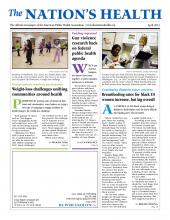A national grassroots effort to teach CPR in minority neighborhoods is necessary, as the skill is missing in many such communities with high rates of cardiac arrest, a recent assessment found.
CPR education in high-risk areas increases the likelihood a person will perform CPR and dismisses fears, such as being sued if a person is unable to save a life, said Comilla Sasson, MD, MS, an assistant professor at the University of Colorado School of Medicine’s Department of Emergency Medicine and lead author of the American Heart Association statement published online Feb. 25 in Circulation.
One life is saved for every 30 people who initiate CPR, but bystanders only perform the task 40 percent of the time, Sasson said. In cities such as Detroit, the survival rate is 0.2 percent for cardiac arrests that happen outside of a hospital, she said.
In neighborhoods where more than 80 percent of residents were black, CPR was performed only 18 percent of the time during a cardiac arrest, according to 2005-2009 data analyzed from the Cardiac Arrest Registry to Enhance Survival. In communities where it was more than 80 percent white, bystander CPR was performed 35 percent of the time.
“To me, this scientific statement really puts the ball in the court of the communities as well as the (American) Heart Association to really take ownership of the fact that these disparities exist,” Sasson told The Nation’s Health. “They’re not going away and we need to rethink about how we disseminate CPR training in the community.”
Sasson’s solution was to pound the pavement in Denver to give out CPR training kits and free lessons on hands-only CPR to community groups. Hands-only CPR eliminates the step of breathing into someone’s mouth. The hope is that people trained in those groups will pay it forward and train others to spread the knowledge, she said.
After more than two years of using mapping technology to identify communities with high rates of cardiac arrest, groups of trainers visited city churches and nonprofits, Sasson said. Since February, trainers taught 44 people CPR in Denver area Vietnamese and Buddhist congregations and 61 representatives from majority-black churches, she said. More than half of the 44 people trained via the Vietnamese and Buddhist congregations trained an additional 142 people how to do CPR, Sasson said.
When asked what the barriers were to getting training, focus groups from Columbus, Ohio and Denver expressed concerns about breathing into the mouth of a stranger, being sued if they did CPR incorrectly and not carrying a card certifying they can administer CPR, Sasson said. Overall, residents said hands-only CPR was easier and faster to learn, she said.
“We have the data that shows hands-only is effective,” Sasson said. “It’s simple, easy to learn. And more importantly, it takes away all those barriers of doing it incorrectly and being sued. I think it’s a big deal.”
Other barriers include potential interaction with police. If someone calling 911 is an illegal immigrant or has a police warrant, she or he may be more hesitant to call 911 in fear of being arrested, she said. Cost is also an issue. Trainers are going out into communities for free but normally it could cost a participant anywhere from $50 to $250 to get CPR training, Sasson said.
“People in high risk neighborhoods make less than $1,000 a month,” Sasson said. “To tell them they have to take a $50 training course is completely cost prohibitive. In the grand scheme of things it’s ‘Do I feed my family, or eat tonight or take a CPR training course?’”
Sasson also said more standardized dispatcher-assisted telephone programs are needed for 911 operators to provide hands-only CPR instructions.
“It’s not enough to just read (instructions),” Sasson said. “You have to do quality improvement and training with the dispatchers to really push for it. As a dispatcher, you really have to be trained well in pushing people out of their comfort zone to do this.”
During a time of tight budgets, Sasson said she challenges the public health community to focus its resources on where it can have the biggest impact when it comes to CPR education.
“If we can figure out how to do this correctly and build that trust, it’s going to be a lot easier for us to open the discussions for what comes next with our community folks,” Sasson said. “And that’s from firsthand experience.”
For more information, visit http://circ.ahajournals.org/content/early/2013/02/25/CIR.0b013e318288b4dd.full.pdf+html.
- Copyright The Nation’s Health, American Public Health Association









